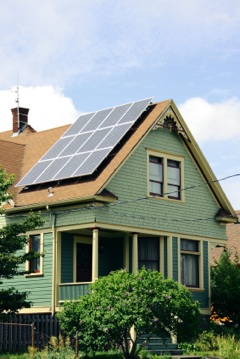Solar Grid Tie System
Grid Tied Solar Options
A Solar Grid Tie System answers a lot of issues about going solar. Tied to the grid, a residential solar power system costs less to establish but still offers the green alternative.
Grid Tied Residential Solar Power
Grid tying has become a mainstream way to get onto the solar bandwagon.
Rather than severing all ties to the grid you can supplement your home energy
needs with solar power and stay tied to the grid.
There are several advantages to you (discussed below) to tying into the grid. Savvy power companies ofer "net-metering", a system by which the company will use
(sell to your neighbors) any excess power you make and pay you for it, on the other hand they'll provide (sell) power
to you when your system isn't making enough. The advantage to the power company is that they don't have to build another expensive power plant to keep up with growing demand.
Energy demand on any power grid is highest during the day and evening hours (particularly in the summer when air conditioners are running). That's right about the time your
solar system is generating the most electricity. With a solar grid tie system you can have it all, a reduction in power bills and greener energy without the substantial costs.
Choose a size that suits your budget. Additionally, a grid tied system doesn't need batteries and they're available in pre packaged systems in a variety of sizes.
Many Countries, States, Provinces and Municipalities are encouraging the use of solar power by offering subsudies, grants and tax credits to homeowners who install a home
solar power system. This "best of both worlds" scenario is great for those who want to use solar power but don't want to spend $30,000.00 on it.

Advantages of a Solar Grid Tie System
Disadvantages
Components include
Regulations
Visitors to our Solar Grid Tie System page may also be interested in the following pages.
Solar Power for Homes
Residential Solar Power






